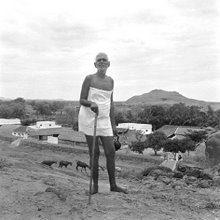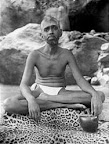HAVING tasted the bliss of the Self, Venkataraman ever abided in the Self and could bear nothing else, nor was anything else possible. Even if the body participated in some activity, thoughts were centred round the Self, he lost body-consciousness too. All this happened naturally and effortlessly.
Abidance in the Self and devotion were the two strands which governed Venkataraman's life. For one who abided in the Self what was the need for devotion to God? This is what Bhagavan had to say on this subject much later, "I was not aware that experience of the Self was categorized and described variously. I was not familiar with philosophic terms like "Brahman" nor what an attributeless Truth meant. I was not aware that the individual Self and Easwara were one. I had an awareness of Easwara but not that it was the atma itself. One cannot say whether the thought process (mind) became extinct or was in abeyance. The Self was being experienced without any effort. In a sense it was abidance in the Self. It was the experience of the unbroken atma in the words of Sankara. In Jnana Vasishta it is described as "sattva pathi."
"Did not Sankara and other self-realised persons worship God with attributes?" One moment it was submergence in the atma at the next it was in God. Sri Ramakrishna Paramahamsa also confirmed the last stages of saints and sages to be similar.
"Other than Periapuranam I had not studied any other spiritual text by then. I had only heard of the Infinite Being with attributes as described therein. I had not heard of any attributeless Truth. Even while being conscious of the external world I was in the presence of Easwara — with no agony, or emotion," said the Swami.
Yogic ways are of two types — the internal and the external. The jnana-marga (path of wisdom) transcends the five sheaths of the body. Raja Yoga is control of mind, whereas Hatha yoga is control of breath. Among the external yogas, the karma [?] and bhakti [?] margas are the most important. They are easily available even to worldly-minded, ordinary people. Among them, the Sankhyas discriminate against the body and attain the attributeless Parabrahman. Or some become devotees, fix their heart on Easwara with attributes, serve him and consider that other than Easwara there is nothing else. For those like Suka who choose the atma as the goal as well as for those devotees who choose Easwara as the goal — the result is the same -- it is the unification of the individual Self and Brahman.
Venkataraman who would earlier visit the temple of Meenakshi only on holy days now became a frequent visitor. On seeing the sport of Sundarareswarar painted in the thousand pillared hall Venkataraman "recollected the emotional upsurge experienced about one year ago on hearing the name of Arunachala." He also was to further recall the life stories of the devotees which could not influence his life then. "I must also be full of bhakti [?] like the Nayanmars, I thought, Easwara, my father at Arunachala, would grant me refuge at his feet. I would frequently visit the temple and in the presence of the images of the Deities and Nayanmars would be beside myself with emotion and would be tear-filled. I did not know what that agony or emotion was due to. All that I would pray for was that the Lord should make me His devotee, or a member of his retinue or one with unswerving devotion. I knew not whether it was joy or sorrow. Either I was in meditation or in that state of agony. My whole body was flooded with this emotion and had a burning sensation. On beholding the images a storm would rise in the mind. Possibly, because the thoughts lost their anchor of the body some other foothold was needed. That was the reason for visiting the temple so frequently. Sometimes, I prayed for mercy, at some other times even that was absent. Tears would stream down, sometimes I would be stupefied".
The only thing that showed itself outwardly in Venkataraman was the streaming of tears, he did not show any other visual characteristics of overwhelming bhakti [?] such as dancing in ecstasy or a choked voice or fainting.
What was the cause for this turmoil? Was it due to some memory of an earlier janma? If so, what kind of experience did that earlier janma have?
Referred Resources:
Links to letters:
prarabdha: (Chapter 116: Prarabdha (Fate)
Links to Ramana Leela:
Periapuranam: (Chapter 5: Earlier Attachment
thousand pillared hall: (Chapter 13: Place of Tapas
Links to gems:
destiny: (Chapter 11: Fate and Freewill





No comments:
Post a Comment